Women Martyrs, Confessors and Early Presbytyrs (Priests)
/St Prisca with lions
Throughout the Church’s history, there have been women and men who witnessed to their Christian faith unto death.
According to ancient tradition, women or men on the way to martyrdom had the power to forgive sins. This is a function of priesthood. The Apostolic Tradition of Hippolytus (3rd cent) states that any confessor who had been imprisoned for faith automatically attains the rank of presbyter (priest) in the Roman communities.
Saints Irenaeus (2nd cent) and Cyprian (3rd cent) apply this power of martyrdom equally to women confessors. It underlines that in the early Church, women, just as did men, shared in the power of the keys — binding and loosening on behalf of Christ. The martyr St. Catherine of Alexandria is shown to have power in the engraving by Albrecht Dührer (see below left). The rack reminds us of her torture, the throne and sword of how she reigns with Christ.
Legend of Saint Prisca
Saint Prisca was a young Roman woman allegedly tortured and executed for her Christian faith. The dates of her birth and death are unknown. She is revered as a pre-schism Western saint and martyr by the Orthodox Church and as a saint and martyr by both the Roman Catholic Church and the Anglican Communion. Though some legends suggest otherwise, scholars do not believe she is the Priscilla (Prisca) of the New Testament couple, Priscilla and Aquila who were friends of the Apostle Paul.
Especially in England, she is honored as a child martyr. January 18 is her feast day.
Not a lot is known about Prisca. It is believed that she came from a noble Roman family and was very young when she died for her faith. She is sometimes represented by two lions, who are said to have refused to attack her at the Co iseum in Rome. Prisca suffered many tortures before she was finally beheaded on the Via Aventine. The Christians buried her body in a catacomb at the place of her death.
There still exists on the Aventine in Rome a church of St Prisca. It stands on the site of a much earlier church, the Titulus Priscoe, mentioned in the fifth century and built probably in the fourth.
Legend says that Saint Prisca was of a noble family. At age thirteen, she was accused of Christianity before Emperor Claudius. He ordered her to make a sacrifice to the god Apollo. When she refused because of her Christian faith, she was beaten and sent to prison.
The martyr St. Catherine of Alexandria is shown to have power in this engraving by Albrecht Dührer . The rack reminds us of her torture, the throne and sword of how she reigns with Christ.
Upon her release from prison, she still held steadfastly to her faith in Christ. This time her punishment included flogging, the pouring of boiling tallow upon her, and a second imprisonment. She was at last thrown to a lion in the ampitheatre but it quietly lay down at her feet.
She was starved for three days in a slaves' prison house, and then tortured upon the rack. Pieces of flesh were next torn from her body with iron hooks, and she was thrown on a burning pile.
She miraculously still remained alive, but was beheaded at the tenth milestone on the Via Ostiensis—the road from Rome to Ostia. The Christians buried her body in a catacomb at the place of her death, where now stands a church of St. Prisca and where previously stood a very early title church, the Titulus Priscoe, mentioned in the fifth century and likely built in the fourth.
________________________
With thanks to John Wijngards, Women’s Ordination Worldwide member group, Wijngaards Institute for Catholic Research and their website womenpriests.org.
- Therese Koturbash, Women’s Ordination Worldwide Communications Team
Therese Koturbash, BA, LLB, GDCL served as Canadian Delegate to Women’s Ordination Worldwide from 2008 to 2013. For all five of those years, she was elected member of WOW's four person International Leadership Circle. She has also been the National Coordinator of Canada's Catholic Network for Women's Equality. Today, Therese serves on WOW’s Communications Team and is a volunteer with WOW member group, Wijngaards Institute for Catholic Research. Her paid work is as a family attorney.


